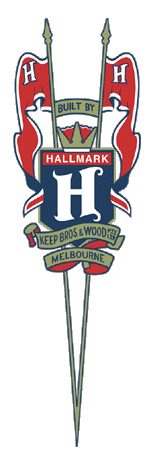| The roadster design of this bicycle made it a very
"ride-able" bike on the sometimes irregular sufaces of Australian roads.
However, weight was not a concern, as a large number of accessories are
fitted to the bike (this was a big-plus for for any kid!)
One strking feature that differentiates the bike from the traditional
English roadster is the use of 28-inch wheels, with 1-3/8 inch tyres (English
roadsters use 26-inch wheels, but taller frame). This wheel size was very
common in Australia, but it seems less common elsewhere in the world where
1-1/2 inch tyres were normally used with 28-inch wheels.
See also, Michael Toohey's comments on the
design of this bicycle.
In original form, the bicycle featured:
-
Reynolds 531 tubing (produced in Adelaide, Sth Aust)
-
Box-style pin-striped finish on black stove enamel
-
Wheel size 28" x 1-3/8" with zinc-plated spokes
-
Dunlop Atlantic tyres, and tubes with Woods-style valves,
-
Ukai (Japan) Endrick pattern rims, chrome plated
-
Cable operated, side-pull, caliper brakes (Made in UK, unknown brand) with
"John Bull" or "Fibrax" #269 brake blocks
-
Sturmey Archer AW (wide ratio) hub gears (4:3, 1:1, and 3:4 ratios)
-
Miller (UK) lighting set, with dynamo on front-left fork
-
"Skidbar" handle bars & "Hallmark" bell
-
T.D.Cross (UK) No. 9 bottom bracket assembly
-
T.D.Cross (UK) head stem bearing assembly
-
Williams (UK) crank set with rat-trap style pedals
-
Lucas (UK) cyclometer
-
Fleet (UK) seat
-
Midland (UK) "Sports Model" pack-rack
-
Bi-pod stand under bottom bracket
-
Leather tool-kit and pucture-repair bag
By the early 1970's, many bicycle manufacturers in Australia began to use
Japanese accessories to reduce costs. By the mid to late 1970's, the design
of this bicycle was considered "past-it". The market - having flirted with
"dragsters" (choppers) - was turning to "racing-style" bicyles, with a
pre-occupation to reduce weight. I too bought a Raleigh racing-inspired
design, but I never felt that it was as forgiving when riding on everyday
(imperfect) surfaces. |

|


